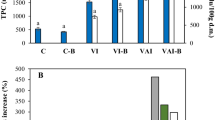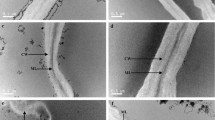Abstract
Texture and mesostructure of packaged fresh-cut ‘Fuji’ apple slices were studied during 30 days storage at 4, 10 and 20 °C. Instrumental mechanical–acoustic texture evaluations were carried out, and cell wall materials were isolated from the flesh tissue by means of an ethanol and methanol–chloroform solvents extraction procedure. The emphasis was on relating the macroscopic loss of fresh texture characteristics to the changes in the rheological properties occurring to the structuring elements of the cell wall materials (CWMs). The rheology of the reconstituted CWM water dispersion was evaluated by means of oscillatory dynamic testing, and viscoelastic data were interpreted according to the ‘weak-gel model’ theory. The dynamics of the flowing components at the mesoscale structural level was related to the texture softening, which yields decrease in firmness and rigidity parameters, and an attenuation of the acoustic emission (fewer acoustic peaks and lower sound pressure level), as it was measured in the combined acoustic–mechanical test. The kinetic reaction rate values are presented. Softening of apple flesh is accompanied by slight cleavage of molecular assemblies and a loss in cell adhesion, mediated by the increase in assemblies’ water uptake. The ability to handle the relationship between the sounds produced during flesh crushing and the structure of the cellular tissue would assist breeders and geneticists in the selection and control of the apple crispness, or would support technologists in preventing postharvest softening during storage and retail.







Similar content being viewed by others
References
Jaeger SR, Andani Z, Wakeling IN, MacFie HJH (1998) Consumer preferences for fresh and aged apples: a cross-cultural comparison. Food Qual Prefer 9(5):355–366
Harker FR, Kupferman EM, Marin AB, Gunson FA, Triggs CM (2008) Eating quality standards for apples based on consumer preferences. Postharvest Biol Technol 50(1):70–78
Harker FR, Gunson FA, Jaeger SR (2003) The case for fruit quality: an interpretive review of consumer attitudes, and preferences for apples. Postharvest Biol Technol 28(3):333–347
Billy L, Mehinagic E, Royer G, Renard CMGC, Arvisenet G, Prost C, Jourjon F (2008) Relationship between texture and pectin composition of two apple cultivars during storage. Postharvest Biol Technol 47(3):315–324
Costa F, Cappellin L, Fontanari M, Longhi S, Guerra W, Magnago P, Gasperi F, Biasioli F (2012) Texture dynamics during postharvest cold storage ripening in apple (Malus × domestica Borkh.). Postharvest Biol Technol 69:54–63
Brookfield PL, Nicoll S, Gunson FA, Harker FR, Wohlers M (2011) Sensory evaluation by small postharvest teams and the relationship with instrumental measurements of apple texture. Postharvest Biol Technol 59(2):179–186
Johnston JW, Hewett EW, Hertog ML (2002) Postharvest softening of apple (Malus domestica) fruit: a review. N Z J Crop Hortic Sci 30(3):145–160
Ortiz A, Graell J, Lara I (2010) Cell wall modifications following cold storage of calcium-treated ‘golden reinders’ apples. In: XXVIII International Horticultural Congress on Science and Horticulture for People (IHC2010): International Symposium on 934, 2010, pp 841–848
Oms-Oliu G, Rojas-Graü MA, González LA, Varela P, Soliva-Fortuny R, Hernando MIH, Munuera IP, Fiszman S, Martín-Belloso O (2010) Recent approaches using chemical treatments to preserve quality of fresh-cut fruit: a review. Postharvest Biol Technol 57(3):139–148
Kader AA (2008) Flavor quality of fruits and vegetables. J Sci Food Agric 88(11):1863–1868
Rosen JC, Kader AA (1989) Postharvest physiology and quality maintenance of sliced pear and strawberry fruits. J Food Sci 54(3):656–659
Rojas-Graü MA, Tapia MS, Martín-Belloso O (2008) Using polysaccharide-based edible coatings to maintain quality of fresh-cut Fuji apples. LWT-Food Sci Technol 41(1):139–147
Dong X, Wrolstad RE, Sugar D (2000) Extending shelf life of fresh-cut pears. J Food Sci 65(1):181–186
Olivas GI, Barbosa-Cánovas GV (2005) Edible coatings for fresh-cut fruits. Crit Rev Food Sci Nutr 45(7–8):657–670
Chen J, Karlsson C, Povey M (2005) Acoustic envelope detector for crispness assessment of biscuits. J Texture Stud 36(2):139–156
Luyten H, Vliet TV (2006) Acoustic emission, fracture behavior and morphology of dry crispy foods: a discussion article. J Texture Stud 37(3):221–240
Varela P, Chen J, Fiszman S, Povey MJW (2006) Crispness assessment of roasted almonds by an integrated approach to texture description: texture, acoustics, sensory and structure. J Chemom 20(6–7):311–320
Do Trong NN, Erkinbaev C, Tsuta M, De Baerdemaeker J, Nicolaï B, Saeys W (2014) Spatially resolved diffuse reflectance in the visible and near-infrared wavelength range for non-destructive quality assessment of ‘Braeburn’ apples. Postharvest Biol Technol 91:39–48
Herremans E, Verboven P, Defraeye T, Rogge S, Ho QT, Hertog ML, Verlinden BE, Bongaers E, Wevers M, Nicolai BM (2014) X-ray CT for quantitative food microstructure engineering: the apple case. Nucl Instrum Methods Phys Res Sect B 324:88–94
Piazza L, Giovenzana V (2015) Instrumental acoustic-mechanical measures of crispness in apples. Food Res Int 69:209–215
Costa F, Cappellin L, Longhi S, Guerra W, Magnago P, Porro D, Soukoulis C, Salvi S, Velasco R, Biasioli F (2011) Assessment of apple (Malus × domestica Borkh.) fruit texture by a combined acoustic-mechanical profiling strategy. Postharvest Biol Technol 61(1):21–28
Zdunek A, Cybulska J, Konopacka D, Rutkowski K (2011) Evaluation of apple texture with contact acoustic emission detector: a study on performance of calibration models. J Food Eng 106(1):80–87
Florkowski WJ, Prussia SE, Shewfelt RL, Brueckner B (2009) Postharvest handling: a systems approach. Academic Press, New York
Riva M, Franzetti L, Galli A (2001) Effect of storage temperature on microbiological quality and shelf-life of ready to use salads. Ann Microbiol 51(1):39–52
Campbell AD, Huysamer M, Stotz HU, Greve LC, Labavitch JM (1990) Comparison of ripening processes in intact tomato fruit and excised pericarp discs. Plant Physiol 94(4):1582–1589
Lin TT, Pitt RE (1986) Rheology of apple and potato tissue as affected by cell turgor pressure. J Texture Stud 17(3):291–313
Niklas KJ (1992) Plant biomechanics: an engineering approach to plant form and function. University of Chicago Press, Chicago
Calbo AG, Ferreira MD (2011) Evaluation of hydration indexes in kale leaves. Braz J Plant Physiol 23(2):141–149
Kirkham MB (2014) Principles of soil and plant water relations. Academic Press, New York
Knee M (1973) Polysaccharide changes in cell walls of ripening apples. Phytochemistry 12(7):1543–1549
Zdunek A, Konopacka D, Jesionkowska K (2010) Crispness and crunchiness judgment of apples based on contact acoustic emission. J Texture Stud 41(1):75–91
Sakurai N (2002) Physical properties of fruit firmness and chemical structure of cell walls during fruit softening. In: Physical methods in agriculture. Springer, US, p 311–341
Vetter S, Kunzek H (2003) The influence of the pre-drying treatment on the hydration properties of dried cell wall materials from apples. Eur Food Res Technol 216(2):129–137
Kunzek H, Opel H, Senge B (1997) Rheological examination of material with cellular structure II. Creep and oscillation measurements of apple material with cellular structure. Zeitschrift für Lebensmitteluntersuchung und-Forschung A 205(3):193–203
Kunzek H, Kabbert R, Gloyna D (1999) Aspects of material science in food processing: changes in plant cell walls of fruits and vegetables. Zeitschrift für Lebensmitteluntersuchung und-Forschung A 208(4):233–250
Gerschenson LN, Rojas AM, Marangoni AG (2001) Effects of processing on kiwi fruit dynamic rheological behaviour and tissue structure. Food Res Int 34(1):1–6
Martínez VY, Nieto AB, Viollaz PE, Alzamora SM (2005) Viscoelastic behavior of melon tissue as influenced by blanching and osmotic dehydration. J Food Sci 70(1):E12–E18
Ramana SV, Taylor AJ (1992) Dynamic measurement of tissue rigidity during freezing and cooking of vegetablesa. J Sci Food Agric 58(2):261–266
Miyazaki K, Wyss HM, Weitz DA, Reichman DR (2006) Nonlinear viscoelasticity of metastable complex fluids. EPL (Europhys Lett) 75(6):915
Yziquel F, Carreau PJ, Moan M, Tanguy PA (1999) Rheological modeling of concentrated colloidal suspensions. J Nonnewton Fluid Mech 86(1):133–155
Redgwell RJ, Curti D, Gehin-Delval C (2008) Physicochemical properties of cell wall materials from apple, kiwifruit and tomato. Eur Food Res Technol 227(2):607–618
Bohlin L (1980) A theory of flow as a cooperative phenomenon. J Colloid Interface Sci 74(2):423–434
Winter HH (1987) Can the gel point of a cross-linking polymer be detected by the G′–G″crossover? Polym Eng Sci 27(22):1698–1702
Gabriele D, de Cindio B, D’Antona P (2001) A weak gel model for foods. Rheol Acta 40(2):120–127
Coppola L, Gianferri R, Nicotera I, Oliviero C, Ranieri GA (2004) Structural changes in CTAB/H2O mixtures using a rheological approach. Phys Chem Chem Phys 6(9):2364–2372
Knee M (1978) Metabolism of polymethylgalacturonate in apple fruit cortical tissue during ripening. Phytochemistry 17(8):1261–1264
Knee M, Bartley IM (1981) Composition and metabolism of cell wall polysaccharides in ripening fruits. Academic Press, New York
Morris ER, Gidley MJ, Murray EJ, Powell DA, Rees DA (1980) Characterization of pectin gelation under conditions of low water activity, by circular dichroism, competitive inhibition and mechanical properties. Int J Biol Macromol 2(5):327–330
Jarvis MC (1984) Structure and properties of pectin gels in plant cell walls. Plant Cell Environ 7(3):153–164
Acknowledgments
The authors kindly acknowledge AGER—Agroalimentare e Ricerca—for financial support within the research project ''STAYFRESH—Novel strategies meeting the needs of the fresh-cut vegetable sector."
Author information
Authors and Affiliations
Corresponding author
Ethics declarations
Conflict of interest
None.
Compliance with Ethics Requirements
This article does not contain any studies with human or animal subjects.
Electronic supplementary material
Below is the link to the electronic supplementary material.
Rights and permissions
About this article
Cite this article
Roversi, T., Piazza, L. Changes in minimally processed apple tissue with storage time and temperature: mechanical–acoustic analysis and rheological investigation. Eur Food Res Technol 242, 421–429 (2016). https://doi.org/10.1007/s00217-015-2553-4
Received:
Revised:
Accepted:
Published:
Issue Date:
DOI: https://doi.org/10.1007/s00217-015-2553-4




